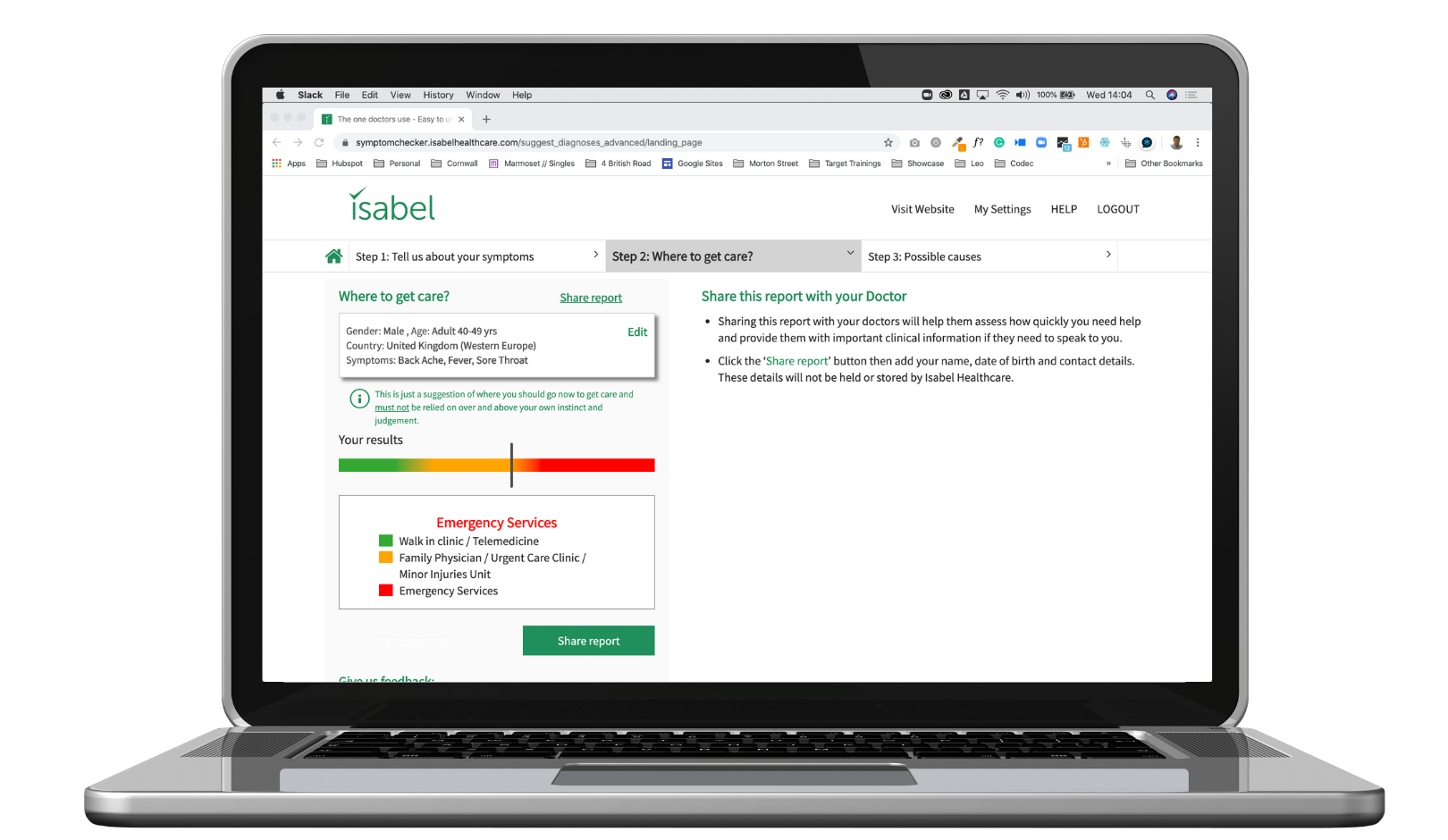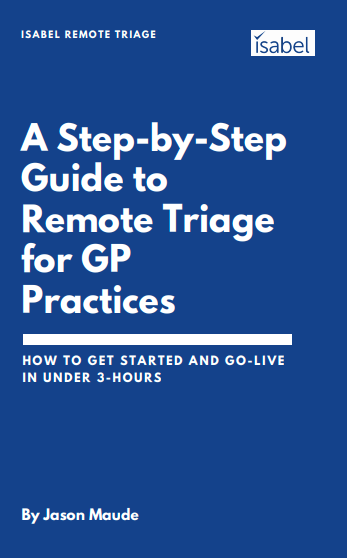
 There are two main types of symptom checker:
There are two main types of symptom checker:These start off by asking for the symptom that’s bothering you most or the symptom you think is most important and then go on to ask upwards of 30-50 questions.
The tool needs to know your ‘most important’ symptom as it’s trying to get you onto a pre-designed model or decision tree from which it can ask you more questions. This can be dangerous as the patient doesn’t necessarily have the knowledge to know what his most important symptom is. Nevertheless, from this stage on, you are placed on a particular decision tree which will influence your final diagnosis. Try choosing a different key symptom or changing the order in which you enter your symptoms and you’ll be surprised how different the results can be!
The aim of these tools is to replicate a doctor’s consultation and come up with a final diagnosis or a list ranked by probability. Generally, the advice they give on where to seek care is dependent on the diagnosis: a heart attack, for example, will need emergency treatment while others, like many cancers, will need you to visit your primary care doctor. The danger for the patient is that this advice relies entirely on the diagnosis the patient has picked, so effectively on the patient diagnosing themselves.
These work a bit more like Google and allow you to enter all your symptoms in one go. However, the difference between a symptom checker and Google is that the symptom checker is purely searching a very specialist database of how diseases present whereas Google is a general search engine, searching everything out there to do with your symptoms. This means that the correct answer may well be in Google’s list but could easily be on page 20! Also, the results in Google are continually affected by organisations trying to influence the results through advertising or what is known as ‘search engine optimisation’. As your health has to be the most important part of your life, we recommend using a tool that is specifically designed for this job and medically validated rather than Google.
Rather than trying to replicate a doctor and diagnose you, machine learning symptom checkers simply try to highlight which diseases most closely match the pattern of symptoms entered. The system is basically searching through a huge volume of medical knowledge and coming up with a shortlist of diseases that match your symptoms. Your job is then to read about them and discuss the shortlist with your doctor.
Some machine learning symptom checkers like Isabel have a triage function. This function looks at your answers to 7 important questions about your symptoms and how you are coping with your daily activities and then combines this with the shortlist of diseases initially suggested to come up with a recommendation of where you should seek care based on your overall clinical state or picture.
 As an initial move, many health institutions have put a COVID-19 symptom checker on their websites. These are very simple decision tree symptom checkers often based on guidance from the CDC in the USA or NHS in the UK and take the patient through a series of questions to assess the risk of a patient having COVID-19.
As an initial move, many health institutions have put a COVID-19 symptom checker on their websites. These are very simple decision tree symptom checkers often based on guidance from the CDC in the USA or NHS in the UK and take the patient through a series of questions to assess the risk of a patient having COVID-19.
However, as we have learnt more about COVID-19, the disease has shown itself to be much more complex than initially thought. Rather than mainly just getting a fever, dry cough or a sore throat at the outset, clinicians have learned that the range of initial symptoms is much, much wider. Also, as the disease has spread, travel history has become irrelevant as an issue compared to community spread. The speed with which new symptoms have emerged presents a real problem for decision tree symptom checkers as they are often out of date as soon as they are launched. This means they run the real risk of falsely reassuring a patient that they probably don’t have COVID-19 if they answer that they haven’t travelled and don’t have a fever or dry cough, for example. A single disease symptom checker also doesn’t consider the many other diseases a patient could have instead of COVID-19.
In contrast, a machine learning symptom checker like Isabel can quickly be trained in the many ways that COVID presents so when a patient enters symptoms that match these possible presentations, Isabel can suggest COVID-19 as a possible disease along with the other relevant diseases. This helps avoid the automatic assumption that a patient has COVID-19 rather than something else which has become increasingly likely with the huge daily attention on the disease.
Since there are now around 40 symptoms of COVID-19, a patient presenting with 3 symptoms can present in up to 10,000 different ways while someone with 4 symptoms will have close to 100,000 permutations. This huge variety explains why a rigid decision tree symptom checker can never handle this vast range of possible presentations.
 Symptom checkers are aimed at patients but can also be a valuable vehicle for interaction between the patient and clinician.
Symptom checkers are aimed at patients but can also be a valuable vehicle for interaction between the patient and clinician. COVID-19 has highlighted the value and importance of the patient being able to clearly articulate their problem remotely to a clinician and the value for the clinician in being able to see this information so they can prioritise which patients need urgent attention. The symptom checker can also provide the clinician with a succinct summary of what they need to know before they speak to the patient.
Initially, clinicians were worried about being overwhelmed by patients unnecessarily visiting their surgery or hospital but this has now turned into concerns that patients are instead presenting too late. This is a significant concern as the health system may well end up being overwhelmed by late cancer and stroke diagnoses rather than COVID-19.
A potential solution to this is encouraging patients to communicate with the institution via a symptom checker. If a patient is worried, they would use the Isabel Symptom Checker and Triage Tool, for example, to describe their problems and give an assessment as to their level of severity. This information would be summarised into a one-page report which would be sent to the GP or hospital. The staff monitoring the incoming forms would be able to prioritise the patients needing care from the severity score provided by the Isabel system and then make sure they were looked at by the appropriate clinician. When the clinician speaks to the patient they would have the key information they needed, thereby saving time when asking the patient about their symptoms and consequently making the call more efficient and effective.

Other symptoms which have been seen in COVID-19 are myalgias, nasal congestion, runny nose, sore throat, neurological symptoms and also gastrointestinal symptoms, including diarrhoea, abdominal pain and vomiting. Chest x-ray findings have included bilateral pneumonia, ground-glass opacities and pneumothorax.
Lab testing has revealed increased lactate dehydrogenase, decreased haemoglobin, neutrophilia, lymphopenia, leucocytosis, thrombocytopenia and thrombocytosis. The 20% who have had a severe form of COVID-19 have developed complications including Acute Respiratory Distress Syndrome (ARDS), acute respiratory injury, septic shock and acute kidney injury. When these patients have developed complications which have required extra ventilatory and intensive care support it has been seen that there is a high mortality rate especially in patients over 65 years of age and those with associated risk factors including diabetes, chronic lung disease or heart conditions.
Initial history taking in a COVID-19 suspected patient initially around a patient’s travel history or being in contact with a COVID-19 confirmed patient. The problem with this was that the disease was spreading easily amongst people by human-to- human transmission and sometimes without any symptoms appearing so the disease took a foothold in many countries at an alarming rate.
Tests for COVID-19 also had to be developed quickly: as many countries have struggled to carry out tests at an effective level to keep up with its rapid spread, it became impossible to isolate patients in time. There is also no effective treatment for COVID-19 or any vaccine to prevent the spread of the disease so people with mild symptoms of suspected COVID-19 have been told to isolate until they are symptom-free so health services around the world can concentrate on the cases which are seriously unwell and need supportive nursing and medical care.
From the various studies which have been released over the past three months the symptoms, lab results and risk factors for COVID-19 amount to around 100 clinical features or findings. Therefore, in order to ensure COVID-19 appears on health professional’s differential diagnosis list, a machine-learning tool like the Isabel Symptom Checker is essential to make sense of this vast array of symptoms.
Rules-based symptom checkers have been unable to have their algorithms tailored to adapt to showing COVID-19 on their differential lists; this is mainly because they work off a chief symptom. COVID-19 has been found to present in a lot of different ways making it impossible to link it to one chief symptom. Isabel has registered these symptoms and presentations and uses them within its algorithm to ensure COVID-19 presents appropriately on its differential diagnosis list as a possible diagnosis.
The addition of Isabel into a service like 111 would, therefore, extend the range of illnesses the service could cover.

Developed, refined and tested over 20 years using Artificial Intelligence technologies, Isabel is the most capable and sophisticated symptom checker available.